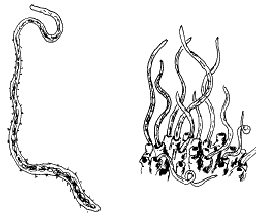Tubifex
| Tubifex | ||||||||||
|---|---|---|---|---|---|---|---|---|---|---|

Tubifex |
||||||||||
| Systematics | ||||||||||
|
||||||||||
| Scientific name | ||||||||||
| Tubifex | ||||||||||
| Lamarck , 1816 |
Tubifex (Latin for tubus "tube" and -fex "-macher"), German sludgetubeworm or brooktubeworm, is a genus of annelid worms that belongs to the Naididae family. The animals are also known to aquarists under the name Tubifex tubifex , but not all worms so named always belong to this species, but often also to one of the other species listed below.
features
The genus Tubifex includes several different species. They reach body lengths of 15 to 85 millimeters. They are usually distinguished by their green color, as well as their living tubes. Like other Naididae , they have long hair bristles dorsally that are in bundles. The skin is smooth; on the 11th segment there is a paired penis. The very similar species of the genera Ilyodrilus and Rhyacodrilus also live in the mud; but they do not form mud pipes.
The tubifex costatus , which lives on the sea coasts, differs from freshwater species in terms of its bristles; he has no hair bristles.
biology
The species of the genus Tubifex live in more or less vertical tubes made of slime and sediment themselves and in the soft sediment of flowing or standing water. If the organic content of the sediment is high, they can occur in large numbers; in unpolluted waters they tend to occur only sporadically. Typically only the rear end of the worms looks out of the sediment surface, showing undulating movements. When disturbed, the worms can quickly withdraw into their tubes.
They have the red blood pigment hemoglobin . This makes it possible for breathing to take place via blood gills (outer gills), which are adequately supplied with blood vessels. This ensures that it can pass into the blood even when there is a lack of oxygen. The constant movement also ensures a supply of fresh water and thus fresh oxygen on the body surface of the animals. The respiration itself via the intestine ( bowel respiration ), the rectum is widely spread for the suction of the water and the water enters into the midgut. Without oxygen, i.e. under anoxic conditions, the animals can survive for several weeks.
Systematics
The best-known and until 1886 only scientifically described species is the common tubifex tubifex . Numerous other species are now known, the following species occur in Europe alone:
- Tubifex ignotus , Stolc, 1886
- Tubifex kryptus , Bülow, 1957
- Tubifex montanus , Kowalewski, 1919
- Tubifex nerthus , Michaelsen, 1908
- Tubifex newaensis , Michaelsen, 1903
- Tubifex pescei , Dumnicka, 1981
- Tubifex pomoricus , Timm, 1978
- Tubifex smirnowi , Lastockin, 1927
- Tubifex tubifex , Müller, 1774, up to about 9 cm in length, the most common species in Central Europe.
Use in the aquarium hobby
Tubifex tubifex and its related species are used by aquarists as live fish feed and are available in specialist pet shops as fresh goods as well as in frozen or freeze-dried form.
supporting documents
- ^ A b Paul Brohmer , Matthias Schaefer : Fauna of Germany. A book of identification of our native fauna . 19th, revised edition. Quelle and Meyer, Heidelberg et al. 1994, ISBN 3-494-01225-3 , p. 522 .
- ↑ a b Gerhard Hartwich : Family Tubificidae - Mud tubeworms. Urania Tierreich, Volume Invertebrates 2, Urania Verlag Berlin 2000; P. 75 f. ISBN 3-332-01174-X .
